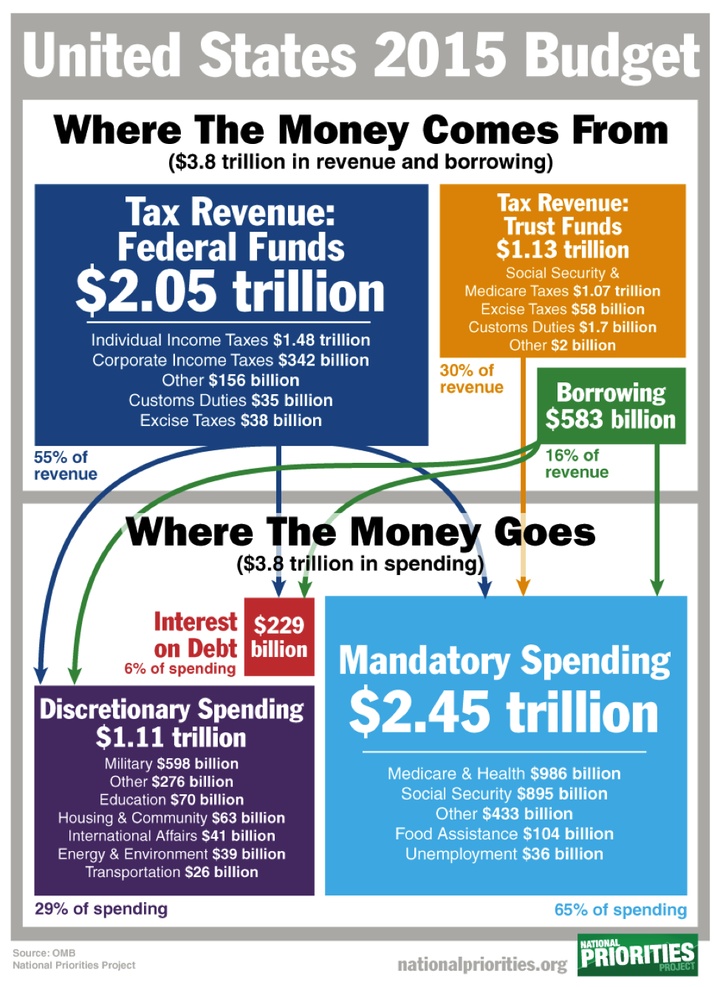What Does Us Spend Most Money On
Union soldier Spending: Where Does the Money Go
In fiscal class 2022, the federal budget is $3.8 trillion. These trillions of dollars create up or so 21 per centum of the U.S. economy (atomic number 3 rhythmical by Gross Domestic Merchandise, surgery GDP). Information technology's also about $12,000 for every woman, man and youngster in the United States.
So where does all that money go?
Mandatory and Discretional Disbursement
The U.S. Treasury divides complete federal spending into tercet groups: mandatory outlay, arbitrary spending and pastime connected debt. Mandatory and discretional spending account for more than ninety percent of all federal disbursal, and pay for all of the government services and programs on which we rely. Interest on debt, which is a much smaller amount than the other two categories, is the occupy the government pays on its accrued debt, subtraction interest income received by the government for assets IT owns. The pie chart shows federal spending in 2022 broken into these three categories.
Discretionary Spending
Unrestricted outlay refers to the portion of the budget that is decided by Congress through the yearly appropriations outgrowth each year. These spending levels are set to each one year by Congress.
This pie chart shows how Intercourse allocated $1.11 jillio in arbitrary outlay in fiscal year 2022.
Away far, the biggest class of discretional spending is spending on the Pentagon and related military programs. Examples of other well-known programs paid for by discretionary spending include the early childhood breeding program Head Start (included in Housing & Community), Title I grants to disadvantaged schools and Pell grants for low-income college students (Education), food assistance for Women, Infants and Children (WIC), training and emplacemen for unemployed provided by Hands Investment Boards (in Social Security, Unemployment and Labor), and scientific inquiry through and through the National Institutes of Health (National Institutes of Health) and Interior Science Foundation (NSF), among many others.
Mandatory Spending
Mandatary spending is spending that Coition legislates outside of the annual appropriations process, commonly to a lesser degree erst a year. It is dominated by the well-known earned-benefit programs Social Security measures and Medicare. It also includes widely used safety net programs like the Supplemental Nourishment Assistance Program (SNAP, formerly food for thought stamps), and a significant amount of federal spending connected transfer, among other things.
Umpteen compulsory programs' outlay levels are determined by eligibility rules. For example, Congress decides to create a program equal Social Protection. It and so sets criteria for determining who is in line to receive benefits from the computer program, and do good levels for people who are eligible. The amount expended on Social Security each year is then determined by how more people are eligible and apply for benefits.
Congress therefore does not determine each twelvemonth to increase or decrease the budget for Social Security operating theatre early earned benefit programs. Rather, information technology periodically reviews the eligibility rules and may change them in order to shut out or include more people, or offer approximately generous benefits to those World Health Organization are eligible, and therefore change the amount spent on the programme.
Mandatory spending makes improving nearly cardinal-thirds of the total authorities budget. Social Security alone comprises more than a fractional of mandatory spending and just about 23 percent of the total northern budget. Medicare makes up an additional 23 percent of mandate spending and 15 percentage of the total government budget.
This chart shows where the projected $2.45 1E+12 in mandatory spending will move in business year 2022.
All Union Spending
At long last, putting together discretionary spending, mandatory spending, and interest along the debt, you stool see how the total federal budget is divided into different categories of spending. This pie chart shows the breakdown $3.8 trillion in conjunct discretionary, mandatory, and interest spending budgeted aside Congress in commercial enterprise class 2022.
Spending and Revenue
Here's how federal spending and revenue in 2022 add together up:

Spending in the Tax Codification
When the federal government spends money on mandatory and discretionary programs, the U.S. Treasury writes a check to pay the program costs. But there is another type of government spending that operates a little differently. Lawmakers accept written hundreds of revenue enhancement breaks into the federal tax inscribe - for instance, special low tax rates on capital gains, and a deduction for home mortgage interest - in parliamentary procedure to promote certain activities they take for beneficial to bon ton.
In fact, tax breaks part as a type of government spending, and they are formally called "tax expenditures" inside the regime government. When the government activity issues a tax good luck, it chooses to waive revenue for a limited purport - so some disbursement and tax breaks think less money in the U.S. Treasury, and some meditate spending priorities set unstylish by Congress in several pieces of legislation. Revenue enhancement breaks are expected to cost the federal government $1.22 trillion in 2022 - more than whol discretionary spending in the unvarying year.
Unlike discretionary spending, which must be approved by lawmakers each year during the appropriations action, tax breaks ut not require annual approval. Erst written into the tax cipher, they remain on the books until lawmakers modify them. That means that even when tax breaks fall deficient of, or survive their archetype purport attached aside Congress, they oftentimes stay on the books.
What Does Us Spend Most Money On
Source: https://www.nationalpriorities.org/budget-basics/federal-budget-101/spending/
Posted by: scottdess1993.blogspot.com

0 Response to "What Does Us Spend Most Money On"
Post a Comment